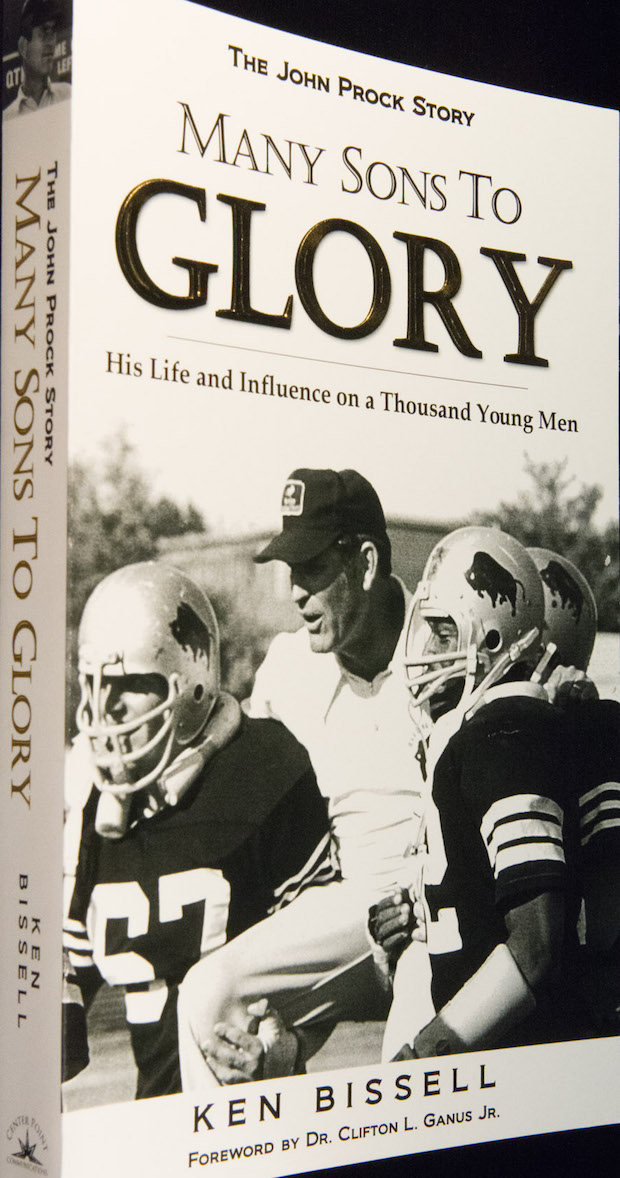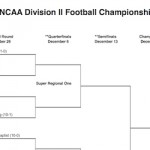Editor’s Note: This is an excerpt from Rex Nelson’s Southern Fried Blog. Enjoy…
 The information that’s compiled on football players and coaches at the NCAA Division II level isn’t nearly as extensive as the plethora of facts and figures we can find on those who play and coach at the BCS level.
The information that’s compiled on football players and coaches at the NCAA Division II level isn’t nearly as extensive as the plethora of facts and figures we can find on those who play and coach at the BCS level.
Ken Bissell, a native of Nashville in Howard County and a graduate of Harding University at Searcy, knew what faced him when he began working on a book about John Prock, Harding’s head football coach from 1964-87. There would be dozens and dozens of interviews to conduct. There would be a lot of digging through old files and scrapbooks.
Google the name of any FBS head coach, and dozens of stories will appear.
Google the name of John Prock, and you won’t find much.
To me, though, John Prock was as big a college coaching name when I was growing up as any head coach in the Southwest Conference, Big Ten or SEC. You see, I was a child of the now defunct Arkansas Intercollegiate Conference, raised by a sporting goods dealer in Arkadelphia in a home that was walking distance from the football stadiums of two AIC schools. If we weren’t in Arkadelphia on a fall Saturday, we were in Searcy, Conway, Russellville, Magnolia or Monticello.
This was college football to me, and the men who were coaching those AIC teams of the 1960s and 1970s — a Prock at Harding; a Benson at Ouachita; a Sawyer, Berry or Carpenter at Henderson; a Dempsey at Arkansas Tech; a Bright or Stephens at what’s now UCA; a Powell at what’s now SAU — were among the giants of my childhood.
Buddy Benson, the head football coach at Ouachita for 31 seasons, was like an uncle to me, and Prock was the AIC coach who — at least in my mind — was most like Benson: A ruggedly handsome, tough, driven man at a private university, forced to compete without the resources of the state schools.
Ken Bissell and I have much in common. We both hail from southwest Arkansas. I graduated from Ouachita in 1981. He graduated from Harding in 1984. We both were heavily involved as students in sports writing and in sports information work at our alma maters. Our mentors were legendary small college sports information directors, Stan Green at Harding and Mac Sisson at Ouachita.
Bissell later would serve as the sports editor of The Nashville News in his hometown and The Daily Citizen in Searcy before returning to Harding as sports information director in 1987. He was a natural to write “Many Sons To Glory,” which was released this fall.
“My relationship with Coach Prock began in 1980 when I was a freshman sports reporter for The Bison, Harding’s student newspaper, and further developed as I worked for four years as a student assistant in the school’s sports information office,” Bissell writes. “I wouldn’t call our relationship close, but I always found Coach Prock to be supportive and encouraging as we interacted through the years. While studying at Harding, I debated between sports writing and coaching as a career path so I pursued a major in journalism with physical education as my minor, which placed me in Prock’s ‘Coaching Football’ class.
“He frequently poked fun at my questions in the classroom, asking if my inquiries were more from a writer’s than a coach’s perspective. I determined quickly that my skills and demeanor were better suited for the press box than the sideline, but I’ve often wondered what might have been had I chosen the life of gridiron mentor over that of journalist and later PR and marketing professional. I have no regrets, it served my family and me well, but I loved coaching my sons’ youth league teams.”
Bissell explains Prock’s “faith in his assistant coaches to squeeze every drop of talent out of the players, and his determination to stretch every dollar, even at his own expense. … Ask his former players how he influenced their lives, and they often speak with such affection that lumps fill their throats and tears come to their eyes. Many of them are successful high school head coaches with multiple state championships.
“But warm feelings from former players and successfully building a program don’t necessarily warrant writing a book about a coach. There are many sports mentors who endear themselves to their teams and face challenges with determination. What set John Prock apart was the grace with which he faced his adversity-filled youth; the faith-based example he demonstrated with his family and the young men who played for him; and the integrity, humility, character and leadership he displayed throughout his life.”
Prock, an inductee into the Arkansas Sports Hall of Fame, died in July 2012. He was born in March 1929 in the small southwestern Oklahoma town of Hollis, which produced a fellow named Darrell Royal, another college football coach you might have heard of.
“Hollis was like any other plains town in the 1920s and ’30s,” Bissell writes. “With a population of a little more than 3,000, it was the county seat and center of commerce in Harmon County where the large majority of residents made their livings as farmers. Hard work in the fields through the week was typically rewarded with a trip to town on Saturday to buy provisions and other necessities and perhaps catch a flicker show at the LaVista movie theater. Sunday was reserved for church services and rest. That reliance on agriculture as the economic lifeblood of the nation’s breadbasket would become the bane of its existence as the Great Depression and severe drought converged to create the perfect poverty storm known as the Dust Bowl.
“The section of country that embraced the panhandles of Texas and Oklahoma, southwestern Kansas, southeastern Colorado and northeastern New Mexico became vulnerable as the influx of homesteaders increased through the first two decades of the 20th century. Endless fields that had served for centuries as the grazing home to buffalo and later cattle herds were converted into millions of acres of wheat in support of World War I food efforts and beyond. Poor land management combined with a three-year drought from 1930-33 eventually destroyed the area’s topsoil. The spring winds of 1934 lifted exposed, parched dirt that was no longer bound together by native grasses and swept it into boiling storms that were aptly called Black Blizzards. Suddenly those whose livelihoods depended solely on crops were left with nothing but silty wind-blown soil covering everything in sight.”
To continue reading the amazing story of Arkansas Hall of Famer John Prock keep reading here…













